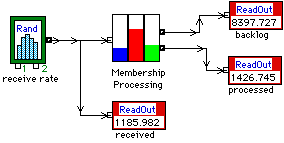
People continue to ask me questions regarding modeling and
simulation, and I continue to give them the same answer, "It
depends!" which they seem very less than satisfied with.
Because of the nature of the questions, this often seems to be
the answer most appropriate. So, in this context I thought I would
ramble on a bit about the nature of "It Depends!" and
why it is so often the most appropriate answer.
I have used this answer so often in a couple of working environments
that it has become a standing point of humor. It has gotten to
the point where people will come to me, ask a question, catch
themself, laugh, and say, "It depends, doesn't it?"
Then they go away and think about it for a while. It has actually
become a basis for learning!
I find it most amazing how we so often get to meaningful places
via quite unpredictable paths. Sometimes its almost a mystical
emergence!
If you have thoughts regarding "it depends" sorts
of things that it might be good to add to this article I'll put
pieces in under your name if you provide the text, or if you just
provide the title I'll ponder it for a while and see what emerges.
One of the most often asked questions relates to whether a
continuous or discrete modeling tool should be used. And yes,
the answer is, "It Depends!" It depends on several aspects
of the system to be considered and it depends even more on the
perspective one wishes to take with regard to the system.
Benjamin Kuipers makes a rather off the cuff comment in the first
chapter of "Qualitative Reasoning: Modeling and Simulation
with Incomplete Knowledge" regarding the nature of change.
Ben says, "In most ways, and at most times, the world changes
continuously." And, if one ponders this for a while, it should
be quite evident that this must be the case. What causes something
to appear or to be described as discrete depends on ones choice,
or unconscious choice, of perception. Actions and events may appear
to be discrete depending on which portions of the real actions
and events we choose to pay attention to, and the manner in which
we pay attention. This perception seems to have everything to
do with the chunking of time frames.
If I watch as water flows into a bathtub, once I turn the faucet
on, it appears to be a rather continuous filling process. Thus
what I perceive is a continuous process as I watch the bathtub
fill little by little over time. If I were instead to turn the
faucet on and then leave the room, and provided I returned before
the tub overflowed, on my return I would notice that that bathtub
was full. So over a period of some number of minutes what I perceive
is a discrete change in the bathtub water level, from empty to
full. And if I were riding on a water molecule experiencing time
in nanoseconds this would all appear a very continuous process.
So the answer depends on the time frame of the events to be considered
and the time frame over which I choose to pay attention to those
events. If the time frame of the events is shorter than the time
one chooses to consider then a continuous perspective is usually
better. If the time frame of events is in the same time frame
one choose to consider then a discrete perspective is usually
better. Sounds rather clear cut doesn't it. Well the universe
just refuses to be this simple. I often find that I have to do
multiple models from differing time perspectives to ensure I have
an understanding I'm comfortable with.
Contents
I have come to understand from a number of sources that there
exists some controversy regarding the basis of model development.
As I understand it there are those that seem to feel there is
great value in beginning with the Archetypes and elaborating them
as warranted by the actual environment being modeled. And, there
seem to be those that content that it is better to begin with
the basic Stock & Flow components and build the model from
essentially nothing but an understanding of the environment being
modeled. So which is best? Yes, you guessed it, "It depends!"
Does the value of something flow from what it is, or what it accomplishes?
What I offer here is somewhat of an autobiographical journey to
whatever level of understanding I now possess, on my way to whatever
is to follow.
It seems there has always been a fascination for the pursuit of
understanding how things work. And it seems that for many years
the pursuit was most misguided. As I now look back I find that
everything was viewed as a machine with parts to be understood
which would provide an understanding of how all the parts worked
together. I followed the Bacon, Descartes, Newton mechanistic
paradigm without knowledge of it.
In college I studied Physics with a passion as it seemed to fit
right in with my mindset. Everything seemed to make so much sense.
In the process I happened across Stafford Beer's "Platform
for Change." It fascinated me, yet being distracted by other
things, nothing that I was aware of became of it for many years.
In the late 80's I happened across a copy of Stella and it seemed
interesting, yet being that it was not perceived to be much in
line with my then current line of work, Management, Marketing,
& Strategic Management, I rather let it pass. Then in 1990
I happened across a copy of Senge's "The Fifth Discipline,"
which I devoured with a passion, and then did nothing with it.
In 1991 I read Senge's book again, convinced someone to shell
out the money and buy me a copy of ithink, and still I did nothing
with it. I guess sometimes things just have to cook a while.
You may find it hard to fathom, yet I read Senge's book again
in 1992 and began to get somewhat interested in the references
he cited. And references lead to references. So I read the works
of Robert Fritz, David Bohm, Donnella Meadows, Jay Forrester,
Kenneth Boulding, Fritjof Capra, Gregory Bateson, Chris Argyris,
Thomas Kuhn, Ervin Laszlo, James Lovelock, Mihaly Csikszentmihalyi,
Eric Jantsch, and many more I don't remember at the moment. Something
was brewing and even though I didn't know why I seemed to have
an insatiable appetite for something.
Somewhere amongst all this reading I ran across Mark Davidson's,
"Uncommon Sense: The Life and Thought of Ludwig von Bertalanffy,"
and things have not been the same since. Amidst a discussion of
the principle of emergence was presented an example so obvious
I almost missed it, "On can study hydrogen and oxygen in
isolation for an eternity and never discover the characteristic
of wetness. Only when studying them as a system in the form of
water will one experience the characteristic of wetness."
At this moment it seemed that about 15 years of bits and pieces
wove themself together in a single coherent fabric of meaning.
In an instant everything seemed to make so much sense. I suppose
this might have been a personal enlightenment which may not make
much sense to others, which is quite ok.
So what does all this have to do with Archetypes vs. Stocks &
Flows? If I were now to build models with only an understanding
of Stocks & Flows I would construct very linear objective
models with no awareness of what was missing, because I wouldn't
know what I didn't know. What the Archetypes now offer me is a
set of very tangible examples of the connectedness of things.
Nothing is quite as simple as A causes B. So now I look for feedback
loops I would never have considered existed, and yet they were
there and exhibited influence.
As an aside, what the Archetypes also offer is a substantiation
of Bertalanffy's initial premise for the foundation of General
Systems Theory, which would have been General Systems Teaching,
were it not for a translation error. Bertalanffy believed there
were a set of fundamental structures which operated in the same
fashion across all disciplines. And, if one learned these fundamental
structures, when they moved from one discipline to another they
wouldn't have to relearn everything from the beginning, but rather
simply learn the specifics of these structures within the new
discipline. Initially I thought this to be very profound, and
as I contemplated the idea it seemed that if the Universe is a
single system, this premise should be obvious. Of course it's
almost always easier to describe the answer once you've seen it.
Getting back to models and non-obvious feedbacks. The following
model developed in Extend is offered as an example. It is a very
simplistic model of an organization that processes membership
applications.

This organization employs 70 people who received about 1,500 applications a day. The average application processing rate is 2.8 forms per hour. Given that on any particular day there are 5 to 10 people out of the office, received applications can be anywhere from 500 to 3,000, and productivity can be all over the map, the organization should not be able to process the number of applications it continues to complete. So how does this happen. Looking in the box rather than at it produces a somewhat different view.
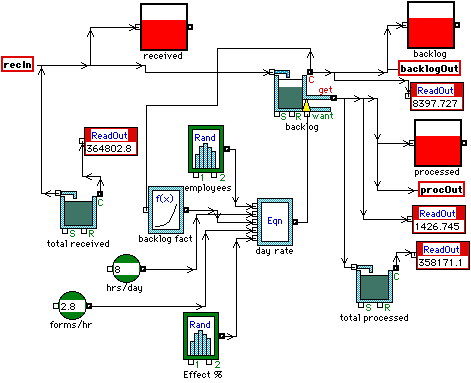
In the midst of this model there is a feedback called "Backlog Fact." This essentially represents the affect the backlog has on the productivity of the organization.

The organization has a belief as to what is an acceptable backlog
level. When the backlog is below the acceptable level productivity
declines. When the backlog exceeds the acceptable level productivity
increases. The system adjusts based on what it believes. And if
one endeavors to drastically alter the operation of this system
without accounting for the belief structure in operation, failure
is most likely.
The Archetypes provided me with a basis for understanding which
enabled the use of Stocks & Flows to construct the representation,
which promoted understanding, which.... Maybe you guessed it,
we have but one more chicken and egg scenario. One without the
other makes no sense whatsoever, and you knew this, didn't you?
Contents
I believe it was William James who said that to prove all crows
are not black it is not necessary to count all black crows. It
is simply necessary to find one white crow. So what follows is
a few words about a white crow, or maybe several white crows.
The Personal Mastery chapter of Senge's Fifth Discipline presents
a very faithful representation of Robert Fritz's concepts regarding
creating the future. The point being that the difference between
what we have and what we want sets up a Creative Tension. This
creative tension promotes action to move us toward what we have,
and at the same time produces an Emotional Tension which promotes
a lowering of the Goal. This scenario is depicted in the following
systems thinking diagram.
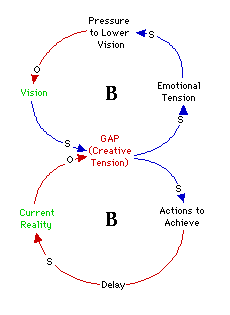
The conflict created by this structure may be represented by the following diagram.

In this structure as we move closer to our vision the tension
created by our belief in our powerlessness and unworthiness to
achieve our vision makes it more and more difficult to move toward
our vision. The opposite is also true. As we move further from
our vision because of our belief in our powerlessness and unworthiness
the tension between current reality and our vision increases and
tends to pull us back in the direction of the vision.
Robert Fritz identified three generic strategies generally used
to cope with conflict.
Each of these strategies have repeatedly proven to be ineffective for coping with conflict. There is a structural conflict which sets up an oscillating structure. As Creative Tension moves you toward your Vision Emotional Tension increases. This Emotional Tension tends to maintain Current Reality. Remaining in Current Reality results in increased Creative Tension which results in actions to move you toward your Vision. This is an oscillating structure which essentially produces no end result, except maybe wear and tear on the individual caught up in it.
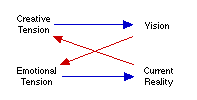
So what is the answer? The answer finally provided by Robert
Fritz is that one must decide what one really wants, and manage
the resulting emotional tension accordingly. The explanation is
actually much longer and more involved than this, and yet this
is essentially the answer. After much consideration this just
seems to be a combination of the previously mentioned low level
strategies for dealing with conflict. So is there really an answer?
The fundamental flaw in all of this seems to be a foundational
belief in the essential nature of either / or. If we believe that
there are two mutually exclusive alternatives then we take actions
as though they are in fact alternative choices where we can have
one or the other. Consider the possibilities if one is not limited
by this belief. Suppose we simply alter the picture or the model
we consider. Consider the following alternative.
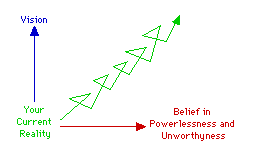
What this diagram is intended to imply is the replacement of
the mutually exclusive nature of either / or by an integration
of the two. This is not a compromise between the two, for compromise
is just another low level strategy for dealing with conflict.
This diagram represents an integration of the two in a manner
which results in something distinctively unique from the two components
which are integrated, much in the same way that hydrogen and oxygen
integrate to produce water.
It seems that the real difficulty with this concept is based in
the dilemma of trying to think of things for which we have no
familiarity and no words to describe. There are many instances
of integration of this sort were we do have a familiarity. Consider
the integration of dependence and independence to create interdependence,
the way differentiation and integration integrate to create complexity.
For years American business believed that lower cost and higher
quality were mutually exclusive alternatives, and the Japanese
provided very painful examples of the limiting nature of this
belief.
If we change the manner in which we view things, and alter what
we believe, it seems that numerous opportunities present themself.
Edward de Bono has commented that the reason we produce such
ineffective answers is that we find thinking painful. As we never
learned how thinking could be fun, we find it a painful chore,
and as such, we consider problems until we find "an answer,"
which we then treat as "the answer" so we no longer
have to think about the problem.
Because of our own actions the solutions we develop are quite
often far less than completely effective. And yet, once we decide
on "the answer" we shift the burden from ourselves to
"the answer." And when the answer proves itself to be
ineffective in really dealing with the situation for which it
was developed it is "the answer" that is at fault, not
the developer of the answer. Yes, there are times when the implementer
of he faulty answer is unjustly held accountable for the failure,
for how could it possibly be the fault of the developer of "the
answer."
Another situation which seem to be most prevalent has to do with
good answers and techniques misapplied. If there is a technique
which as worked wonders within many large organizations then it
must be a sound technique and it should produce the same results
in another organization. So the technique or method is applied,
with little thought, as thinking in painful. And when the technique
doesn't produce the desired result then most certainly it must
be the technique that is at fault, for it couldn't possible be
me.
This seems to be the very foundation of management fads. The application
of apparently proven methods and techniques which, when they don't
produce the expected results, are passed by in favor of the next
new management fad.
So where's the answer? Who's at fault? Well, "it depends!"
And it doesn't really depend. No one is at fault, and we're all
at fault. Culture perpetuates! We learned how to approach problems
form those that came before us, and we approach problems in much
the same fashion. If an educational systems teaches one to conform
and perform should it be of any surprise that the product created
is not insightful and creative?
If we continue to pursue "the answer," asking others
for "the answer," and shrugging off those that don't
provide "the answer," we will produce a common understanding
that what is valued it the delivery of "the answer."
Thus the entity produces its own culture by its actions, without
much awareness on its part of what it is actually doing. And when
it finds it has a culture is does not like the entity asks, "How
could this possibly have happened?" And the entity is most
unwilling to listen to any proposition that tends to imply that
the current situation is one that the entity was itself responsible
for creating.
Contents
This is rather an autobiographical note developed from a perspective
of my own personal experience. When developing models with the
intent of performing simulations, where is the best place to start?
I suppose this is a dilemma I wrestled with for years. The most
difficult part of every modeling effort was the "blank paper
syndrome." Given a blank piece of paper to start with I was
constantly concerned about where to being. At times I was so concerned
about where to begin I actually didn't begin. The concern was
so great it precluded progress.
As I came to understand systems I finally realized it really didn't
matter where one started. Because of the interconnectedness of
systems wherever one starts is fine. With an earnest endeavor
to develop an understanding of the system an appropriate description
of the system will emerge regardless of where one begins. The
most important aspect of developing understanding is to begin.
When I realized this I seemed to become much more productive in
the development of models, and through the experience of developing
models they seem to have become better.
Contents